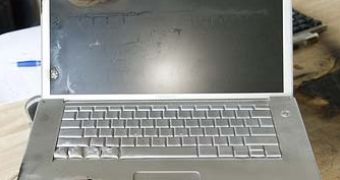Apple and Sony have jointly decided to settle the lawsuit filled with a Japanese couple that claim physical injuries related to their Mac battery bursting into flames. According to the lawsuit, the husband suffered severe injuries after the battery manufactured by Sony and shipped inside their Apple system caught fire.
However, the two companies that seem to be carrying the guilt for the incident decided to jointly pay the couple 1.3 million yen (around $13,000) in physical damage. The three involved parties reached an agreement and the settlement was signed at the Osaka District Court. However, neither Sony, nor Apple were available for comments regarding the settlement.
The lawsuit was filled last July, and the couple sought 2 million yen in damage. The legal action was based on the couple arguing that their computer caught fire out of the blue, as the wife was using it at the couple's residence in Osaka, back in April 2006. The fire was strong enough to burn part of the floor and the adjacent carpet and burn the husband's fingers as he tried to take the notebook away.
Despite the fact that Apple took responsibility of the incident, the company's lawyers could not settle the case outside the court, as the couple's compensation demands were labeled as "excessive". More than that, Sony claimed that the incident cannot be related to the products it manufactures and withdrew from the lawsuit.
However, Sony's batteries are alleged to play a significant part in the events, and you might remember the massive battery recall it ordered. The company pulled off about 9.6 million batteries based on the lithium-ion technology, as the number of fire reports in notebooks reached alarming peaks.
LG was also the subject of a few lawsuits regarding the safety of its batteries, and the company was forced to conduct extensive tests on its products. The lithium-ion technology uses a mixture of compounds that are highly unstable when overheated, but it is the only viable technology that can suit the power-hungry mobile applications.

 14 DAY TRIAL //
14 DAY TRIAL //